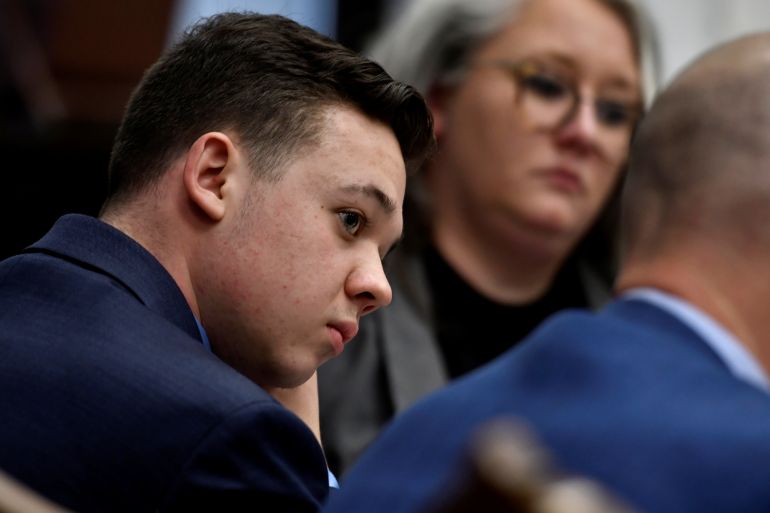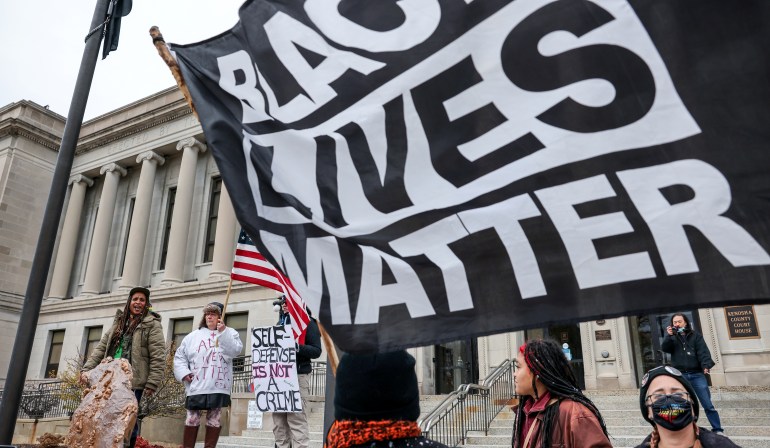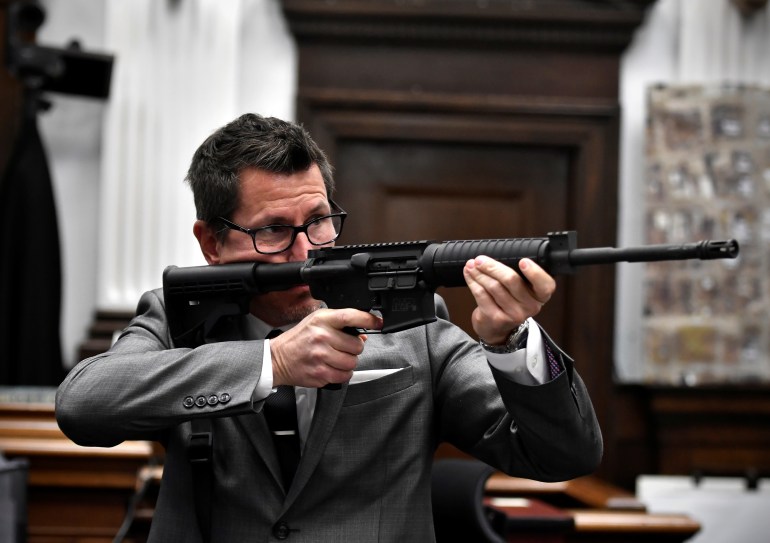Kyle Rittenhouse trial: ‘Self-defence’ vs ‘provoked everything’
Rittenhouse, who has pleaded not guilty and testified that he acted in self-defence, faces life in prison if convicted.

Jury deliberations in the murder trial of Kyle Rittenhouse got under way on Tuesday after two weeks of polarising testimony that has gripped the United States and sparked concerns over how the public may react once a verdict is rendered.
Rittenhouse brought a semi-automatic weapon to a protest to menace others, provoked bloodshed in the streets, and after the shooting, walked off like a “hero in a Western,” a prosecutor said during closing arguments on Monday.
Keep reading
list of 3 itemsSurvivor tells US court he saw Rittenhouse as ‘active shooter’
Rittenhouse claims self-defence in dramatic US court testimony
But Rittenhouse’s lawyer countered that argument, saying that the shooting started after the young man was ambushed by a “crazy person” that night and became afraid his gun was going to be wrested away and used to kill him.
Rittenhouse was 17 when he killed two men and wounded a third during a tumultuous night of protests against racial injustice in August 2020, which erupted after the death of George Floyd, a Black man killed by a white police officer who knelt on his neck for more than nine minutes as Floyd pleaded, “I can’t breathe.”
The Rittenhouse case has stirred bitter debate in the US over guns, racial tensions, vigilantism, and law and order.
Rittenhouse said he went to Kenosha, Wisconsin, from his home in nearby Antioch, Illinois, to protect property from rioters in the days after a Black man, Jacob Blake, was shot seven times and severely injured by a white police officer. Rittenhouse, a former police youth cadet, is white, as were those he shot.
In closing arguments, prosecutor Thomas Binger repeatedly showed the jury drone video that he said depicted Rittenhouse pointing the AR-style weapon at demonstrators.
“You cannot hide behind self-defence if you provoked the incident. If you created the danger, you forfeit the right to self-defence by bringing that gun, aiming it at people, threatening people’s lives. The defendant provoked everything,” Binger told the jury.
Rittenhouse, now 18, faces a mandatory sentence of life in prison if convicted of the most serious charge against him, first-degree intentional homicide, which is Wisconsin’s top murder charge.
Binger zeroed in on the killing of 36-year-old Joseph Rosenbaum, who was the first man gunned down that night and whose shooting set in motion the bloodshed that followed. The prosecutor repeatedly called it murder, saying it was unjustified.

The prosecutor reminded jurors that Rittenhouse testified he knew Rosenbaum was unarmed. Binger also said there is no video to support the defence claim that Rosenbaum threatened to kill Rittenhouse.
Binger disputed the notion that Rosenbaum was trying to grab Rittenhouse’s rifle. “Mr Rosenbaum is not even within arm’s reach when the first shot occurs,” Binger said. He rejected the idea that Rittenhouse had no choice but to shoot, saying he could have run away.
And Binger argued that once Rosenbaum was wounded, he was not even capable of taking away the gun, which was strapped to Rittenhouse’s body. Rittenhouse kept firing, delivering what the prosecutor called the “kill shot” to Rosenbaum’s back.
“I think we can also agree that we shouldn’t have 17-year-olds running around our streets with AR-15s, because this is exactly what happens,” Binger said.
In his own closing argument, defence lawyer Mark Richards called Rosenbaum a “rioter” and a “crazy person” who went after Rittenhouse.
“Mr Rosenbaum was shot because he was chasing my client and going to kill him, take his gun and carry out the threats he made,” Richards said, adding that Rittenhouse was then attacked by a “mob”.
Richards summarised the testimony of witnesses who have appeared over the past two weeks, saying the prosecution had failed to prove its case. Of Rittenhouse’s testimony, he said the accused did not have to testify but wanted to tell his own story.
Richards also showed footage of the evening, contending it proved that Rittenhouse feared for his life.
“There was no threatening behaviour that caused this,” Richards said, dismissing the prosecution’s contention that Rittenhouse provoked the violence.
“Every person who was shot was attacking Kyle,” he said, with hands, feet, a skateboard and a gun.
“Kyle Rittenhouse’s behaviour was protected under the law of Wisconsin, the law of self-defence.”
After killing Rosenbaum, Rittenhouse shot and killed Anthony Huber, 26, and wounded Gaige Grosskreutz, 28, while trying to make his way through the crowd.
Rittenhouse testified that Huber hit him with a skateboard and that Grosskreutz came at him with a gun of his own – an account largely corroborated by video and some of the prosecution’s own witnesses.
But Binger said Rittenhouse provoked the bloodshed that followed Rosenbaum’s shooting: Huber, Grosskreutz and others in the crowd were trying to stop what they believed was an active attacker.

When it was all over, Rittenhouse walked away like a “hero in a Western – without a care in the world for anything he’s just done,” Binger said.
Richards said only the prosecution saw Rittenhouse as an “active shooter” that no one in the crowd on August 25, 2020, thought that.
The jury is expected to begin deliberations on Tuesday.
Supporters have hailed Rittenhouse as a hero who took a stand against lawlessness, while foes have branded him a vigilante.